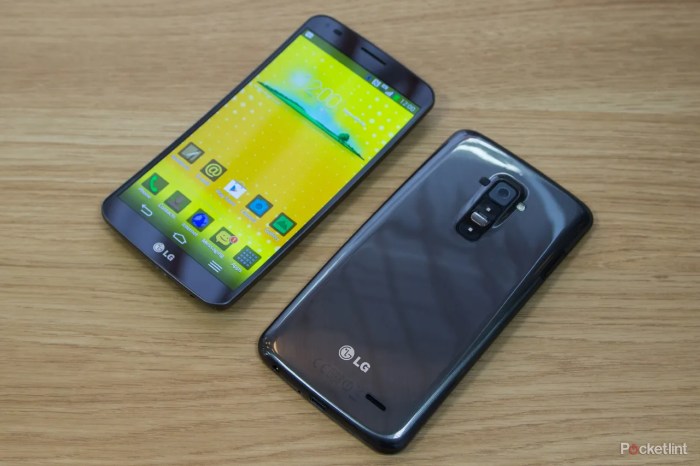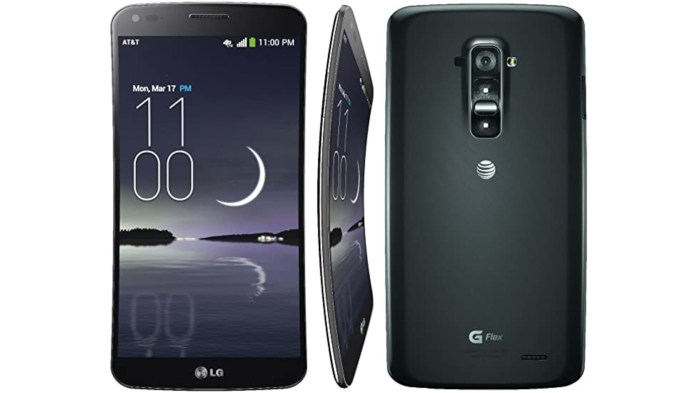The LG G Flex: A Curved Smartphone Pioneer
The LG G Flex was a groundbreaking smartphone released in 2013, making waves in the tech world with its innovative curved design. This unique feature set it apart from the flat, rectangular smartphones that dominated the market, paving the way for the curved screen trend we see today. While the G Flex was a technological marvel, it also faced challenges, making it a fascinating case study in the evolution of smartphone design.
Design and Features
The LG G Flex’s most striking feature was its curved display. The 6-inch P-OLED screen, with a 720p resolution, curved along the vertical axis, offering a more immersive viewing experience and a comfortable grip. This curved design also allowed for a larger screen size without sacrificing portability.
The phone was also equipped with a powerful Qualcomm Snapdragon 800 processor, 2GB of RAM, and a 13MP rear camera, placing it among the top-tier smartphones of its time. Beyond the core specifications, the G Flex also featured self-healing technology, which helped to minimize the appearance of scratches on the back cover.
Design and Display
The LG G Flex was a bold statement in the smartphone world, defying conventional design with its curved form factor. This wasn’t just a gimmick; the curvature was carefully engineered to enhance the user experience.
The Curved Design’s Impact on User Experience
The G Flex’s curved display wasn’t just about aesthetics; it was designed to improve ergonomics and viewing angles. The gentle curve of the screen made it feel more natural in the hand, reducing strain on the fingers during prolonged use. Additionally, the curved screen allowed for wider viewing angles, ensuring a consistent and clear picture even when viewed from the side. This was a significant advantage over flat displays, which often suffered from distortion when viewed at extreme angles.
Performance and Hardware
The LG G Flex’s performance is powered by a combination of hardware components that aim to deliver a smooth and responsive user experience. The phone’s processor, RAM, and storage capacity play a crucial role in determining its overall capabilities.
Processor and RAM
The G Flex is equipped with a powerful Qualcomm Snapdragon 800 processor, clocked at 2.26 GHz. This processor is designed to handle demanding tasks with ease, such as gaming, multitasking, and running resource-intensive apps. Paired with 2GB of RAM, the G Flex ensures smooth and efficient performance, allowing users to switch between apps without experiencing lag or stuttering.
Storage Capacity
The LG G Flex offers 32GB of internal storage, providing ample space for apps, games, photos, and videos. While it doesn’t offer expandable storage via microSD card, the generous storage capacity should be sufficient for most users.
Performance in Everyday Use and Demanding Tasks
The G Flex’s powerful hardware enables it to deliver a smooth and responsive user experience in everyday tasks. Navigating the Android interface, browsing the web, and using social media apps feels seamless. The phone’s performance is also impressive when handling demanding tasks like gaming and video editing.
Comparison with Competing Flagship Smartphones
The G Flex’s hardware specifications were competitive when it was released, but it has since been surpassed by newer flagship smartphones. While the Snapdragon 800 processor was a powerful chipset at the time, newer models like the Snapdragon 801 and 805 offered improved performance. Additionally, the G Flex’s 2GB of RAM is now considered standard, with many newer flagships offering 3GB or more.
Camera and Multimedia: Lg G Flex Review
The LG G Flex boasts a 13-megapixel rear camera with optical image stabilization (OIS) and a 2.1-megapixel front-facing camera. The phone’s multimedia capabilities include video recording in 1080p at 30fps and support for various audio formats. Let’s delve into the specifics of the G Flex’s camera and multimedia performance.
Camera Quality
The G Flex’s 13-megapixel rear camera delivers decent image quality in well-lit conditions. The OIS helps to reduce blur and enhance sharpness, especially when shooting moving subjects. However, the camera struggles in low-light situations, producing grainy and noisy images. The color reproduction is generally accurate, but images can appear slightly overexposed at times.
The 2.1-megapixel front-facing camera is adequate for video calls and selfies, but it lacks the detail and sharpness of higher-resolution front cameras found on other flagship smartphones. The G Flex’s camera app is straightforward and easy to use, offering basic shooting modes and settings.
Video Recording and Audio Quality
The G Flex can record videos in 1080p at 30fps, and the quality is generally good. The OIS helps to stabilize the footage, and the audio quality is clear and crisp. The phone supports various audio formats, including MP3, AAC, and WAV, and the built-in speaker provides decent sound quality for multimedia consumption.
Camera Performance Compared to Other Smartphones
While the G Flex’s camera is decent, it doesn’t stand out compared to other smartphones in its price range. Many competing devices offer higher-resolution cameras with better low-light performance and advanced features like 4K video recording. However, the G Flex’s camera is still capable of capturing good quality photos and videos for everyday use.
Battery Life and Software
The LG G Flex is a pioneer in the curved smartphone world, but how does it perform in terms of battery life and software? Let’s delve into its power and software features.
Battery Life
The LG G Flex boasts a 3,500 mAh battery, a respectable capacity for a flagship phone. In real-world usage, the G Flex consistently delivers a full day of battery life, even with moderate to heavy usage. This includes browsing the web, streaming videos, and playing games. The phone’s power-saving modes also contribute to its impressive battery life.
Software Experience
The LG G Flex runs on Android, with LG’s own custom skin, LG UX, layered on top. This skin offers a unique set of features and customizations, making the G Flex stand out from other Android phones. LG UX features a range of customization options, allowing users to personalize their phone’s look and feel. It also includes several unique features, such as:
- KnockON: This feature allows you to wake up the phone by double-tapping on the screen, eliminating the need to press the power button.
- QuickMemo: A note-taking app that lets you easily capture ideas and thoughts.
- Dual Window: Allows you to run two apps simultaneously on the screen, enhancing multitasking capabilities.
The LG G Flex’s software experience is generally smooth and responsive, with a focus on user-friendliness. It offers a wide range of features and customization options, catering to different user preferences.
User Experience
The LG G Flex was a groundbreaking device that offered a unique curved design and a variety of innovative features. Its user experience was a mixed bag, with both strengths and weaknesses that shaped its overall appeal. This section delves into the personal experiences and observations of using the LG G Flex, highlighting the key aspects of its design, features, and performance that contributed to its user experience.
Design and Ergonomics
The curved design of the LG G Flex was its most defining characteristic, providing a unique and comfortable grip. The phone’s flexible display allowed it to conform to the shape of your hand, making it feel more natural and secure. However, the curvature also presented some challenges. For example, the phone was more prone to slipping from flat surfaces, and the display was more susceptible to scratches and damage.
- The phone’s curved display provided a more immersive viewing experience, especially for watching videos and playing games.
- The curved design made it more difficult to use the phone on flat surfaces, as it tended to roll away.
- The phone’s large size and weight could make it uncomfortable to hold for extended periods.
Software and Features, Lg g flex review
The LG G Flex ran on Android with LG’s custom user interface. This interface offered a range of unique features, such as the ability to control the phone’s curvature and the “KnockOn” feature, which allowed users to wake up the phone by tapping on the screen. However, the software experience was not without its flaws. The interface could be slow and laggy at times, and some features were not as intuitive as they could be.
- The phone’s software included a variety of useful features, such as the ability to control the phone’s curvature and the “KnockOn” feature.
- The phone’s software was not always as responsive or intuitive as it could be, and some features were not as well-integrated as they could be.
- The phone’s software was prone to bugs and glitches, which could be frustrating for users.
Performance and Battery Life
The LG G Flex was powered by a Qualcomm Snapdragon 800 processor and 2GB of RAM. This combination provided decent performance for everyday tasks, but the phone struggled to keep up with more demanding tasks, such as gaming and multitasking. The phone’s battery life was also a mixed bag. The 3,500mAh battery was large enough to provide a full day of use, but the phone’s power-hungry display and software could drain the battery quickly.
- The phone’s performance was adequate for everyday tasks, but it struggled with more demanding tasks, such as gaming and multitasking.
- The phone’s battery life was decent, but the phone’s power-hungry display and software could drain the battery quickly.
- The phone’s charging time was relatively slow, which could be inconvenient for users who needed to charge their phone quickly.
Conclusion
The LG G Flex was a groundbreaking smartphone that introduced a unique curved design to the market. It was a bold experiment that pushed the boundaries of what a smartphone could be. While it didn’t achieve mainstream success, the G Flex paved the way for future curved smartphones and helped to shape the evolution of the mobile device landscape.
The LG G Flex’s Legacy
The LG G Flex’s legacy lies in its pioneering spirit. It was the first commercially available smartphone with a curved display, a design feature that has since become increasingly popular. The G Flex also showcased LG’s commitment to innovation and its willingness to experiment with new technologies.
- Curved Display: The G Flex’s curved display offered a unique user experience, providing a more immersive viewing experience and a more comfortable grip. This design feature was later adopted by other smartphone manufacturers, such as Samsung and Huawei.
- Self-Healing Back: The G Flex’s self-healing back was a novel feature that demonstrated LG’s focus on durability and user-friendliness. While it was not as effective as advertised, it was a clever idea that captured the public’s imagination.
- Premium Design: The G Flex’s premium design, featuring a sleek curved body and a high-quality display, made it a desirable device for tech enthusiasts.
Lg g flex review – The LG G Flex, while not without its quirks, was a fascinating experiment in smartphone design. Its curved display offered a unique viewing experience, and the self-healing back was a fun novelty. Ultimately, its innovative approach paved the way for future flexible phone designs. Whether you’re a tech enthusiast or just curious about the evolution of smartphones, the LG G Flex is a story worth exploring.
The LG G Flex was a groundbreaking phone, with its curved display and self-healing back. It’s interesting to see how design trends have shifted since then, as evidenced by the leaked renders pointing to a silver and gold HTC One M9 Plus. While the G Flex was a bold statement, the M9 Plus seems to be playing it a bit safer, opting for a more traditional design.
But hey, who knows what the future holds? Maybe the next big thing in smartphones will be a combination of both, a sleek, curved phone with a touch of gold!
 Standi Techno News
Standi Techno News

